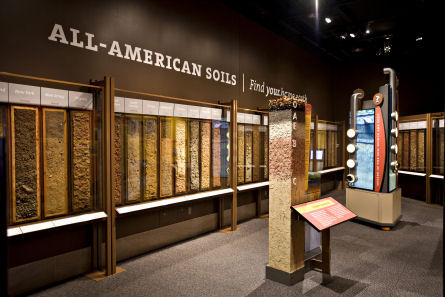The Good Earth
Normal 0 false false false MicrosoftInternetExplorer4
Normal 0 false false false MicrosoftInternetExplorer4

Did you know that there are more living creatures in a shovel full of soil than people on the planet? Or that it may take up to 500 years to produce one inch of topsoil?
These provocative teasers from the Soil Science Society of America succeeded in drawing me to the media preview, this morning, of a 5,000-square-foot exhibit that it’s cosponsoring at the Smithsonian’s National Museum of Natural History. Eight years in the making, it’s titled: “Dig It! Secrets of Soil.”
Pat Megonigal, the exhibit’s curator and a scientist with the SmithsonianEnvironmentalResearchCenter, noted that from the outset, his staff realized it would be a challenge to make soil sing — and draw visitors into an exhibitory cul de sac featuring what many people view as just dirt.
And soils’ competition will be stiff. Every year some 7 million visitors pour into this Smithsonian facility, the world’s largest natural history museum. Many tourists arrive having already planned their sojourns carefully. They’re likely to make an initial beeline straight to the fabled Hope diamond, dinosaur reconstructions, or the creepy crawly Insect Zoo.
To counter dirt’s lackluster reputation, Megonigal’s crew developed interactive presentations and a video that borrowed from the popular TV shows CSI and Iron Chef. The goal: to sell museum goers on the mysteries in soil and the myriad recipes behind winning soils.
As an inveterate gardener, granddaughter of farmers, and a founding member of the Society of Environmental Journalists, I’m hardly naïve when it comes to the value of soil. Still, I learned several cool factoids today. Such as:
— 1 teaspoon of good farm soil will contain roughly a billion bacteria coming from some 4,000 distinct species. What the exhibit didn’t say (but its curator did during his opening remarks) is that most of those bacterial species have not yet been identified.
— one might think of some soil bacteria as making biofuels. For instance, Clostridium phytofermentans makes ethanol. Needless to say, these “bugs” don’t make that byproduct in marketable reservoirs.
— one earthworm — Megascolides australis — grows up to eight feet long.
— and some soils are electric owing to certain microorganisms that take electrons from various chemicals and combine them with others, such as oxygen, nitrogen or sulfur. The exhibit notes that some of these bugs have actually been tapped in experimental setups to create microbial batteries.
I toured the exhibit and have to say that on a scale of 1 to 5, I’d rank its coolness factor at about 2.5. The displays were educational, but not uniformly in a fun and memorable way. I’d have liked more amazing factoids, and then a paragraph or two to amplify the statements.
One display that caught my attention — in a positive way — compared the carbon-dioxide emissions per cubic centimeter of soil in tropical forests versus African savannahs. My problem: The display appeared to be capturing emissions in a device and offering an instantaneous readout — but failed to give units for CO2 values that a display showed accumulating in real time. So I asked a member of the Smithsonian public-affairs team what the CO2 units were. She hadn’t a clue, so she brought over Megonigal, who thought and thought. Eventually he decided the CO2 numbers “must be atoms.”
You mean molecules? “Uh yeah,” he responded.
By the way, this display didn’t actually measure anything. It showed what turned out to be “simulated” soil undergoing an equally simulated real-time assay (which I only learned upon asking Megonigal about why so much CO2 was being emitted by what looked like dead soil).
One highlight of the new exhibit, at least from Megonigal’s point of view, were the 54 soil samples (each of which looked to be about 5 feet high) loaned to the museum by the Agriculture Department. They’re indeed real — and depict the degree to which soils vary in color, composition, and density. Unfortunately, this display is static and didn’t really offer enough information to explain the differences between the soils and what aspects made those differences interesting.
Another thing I wish had made it into the exhibit was Megonigal’s statement about how much of soil science remains a mystery. As he put it, although all terrestrial life depends on soils, these are “living, breathing bodies . . . that we know less about than the dark side of the moon.”
Killer art could have helped invigorate this exhibit. I’m talking about photos like those that fill the adjacent Ocean Views room. There, huge and literally breathtakingly stunning super-high-resolution photos depict the marine world and its inhabitants.
Dig It! will opens Saturday (July 19) and runs through 2010. After that, it’s expected to begin a road show to museums around North America through 2013. The exhibit was sponsored by SSSA and the Nutrients for Life Foundation (a nonprofit educational arm financed by the Fertilizer Institute and agrichemical industry).






